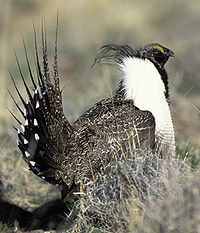Grouse
| Grouse Temporal range: Early Pliocene to recent |
|
|---|---|
 |
|
| Male sage grouse Centrocercus urophasianus |
|
| Scientific classification | |
| Kingdom: | Animalia |
| Phylum: | Chordata |
| Class: | Aves |
| Subclass: | Neornithes |
| Infraclass: | Galloanserae |
| Order: | Galliformes |
| Family: | Phasianidae |
| Subfamily: |
Tetraoninae Vigors, 1825 |
| Genera | |
|
Bonasa |
|
| Synonyms | |
|
Tetraonidae Vigors, 1825 |
|
Bonasa
Falcipennis
Centrocercus
Dendragapus
Lagopus
Tetrao
Tetrastes
Tympanuchus
and see text
Tetraonidae Vigors, 1825
Grouse /ˈɡraʊs/ are a group of birds from the order Galliformes, in the family Phasianidae. Grouse are frequently assigned to the subfamily Tetraoninae (sometimes Tetraonidae), a classification supported by sequence studies, and applied by the American Ornithologists' Union,ITIS, and others. Grouse inhabit temperate and subarctic regions of the Northern Hemisphere, from pine forests to moorland and mountainside, from 83°N (rock ptarmigan in northern Greenland) to 28°N (Attwater's prairie chicken in Texas).
Grouse are heavily built like other Galliformes such as chickens. They range in length from 31 to 95 cm (12 to 37 in), and in weight from 0.3 to 6.5 kg (0.66 to 14.33 lb). Males are bigger than females—twice as heavy in the western capercaillie, the biggest member of the family. Grouse have feathered nostrils. Their legs are feathered to the toes, and in winter the toes, too, have feathers or small scales on the sides, an adaptation for walking on snow and burrowing into it for shelter. Unlike other Galliformes, they have no spurs.
...
Wikipedia
